Ultrabook Head to Head: Acer Aspire S3 vs. ASUS UX31E
by Jarred Walton & Manveer Wasson on December 21, 2011 5:40 AM ESTAnd Then We Get to the LCDs…
Sadly, as much as some areas of the laptops are improved over other offerings, the displays in general are nothing to get excited about. The Acer LCD is a bog standard model while the ASUS goes for a higher HD+ resolution and one of the brightest backlights we’ve tested on a laptop; unfortunately, contrast ratio along with color quality and gamut are all in the dumps. Let’s not dwell on it too much before we see the charts.
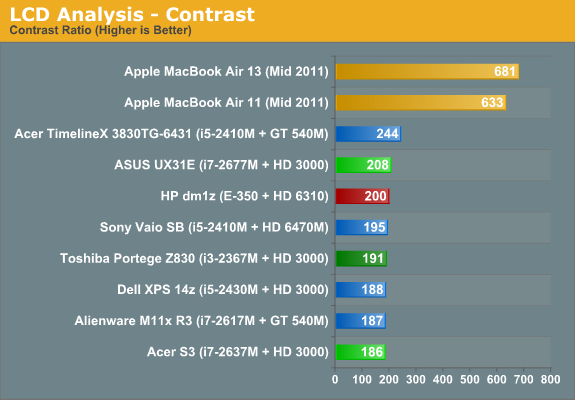
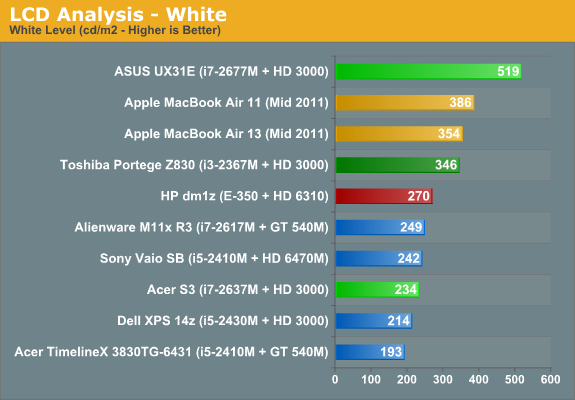
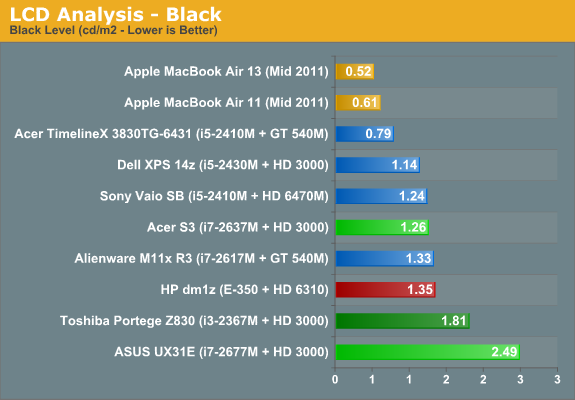
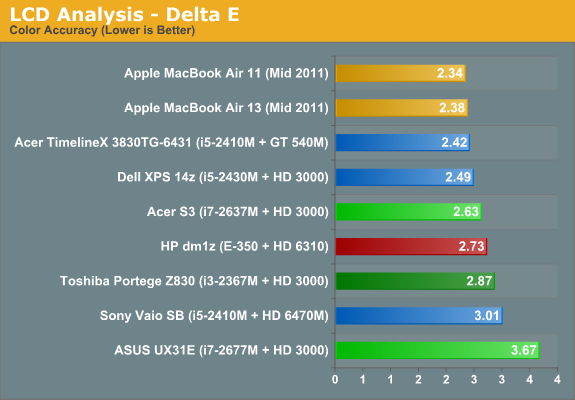
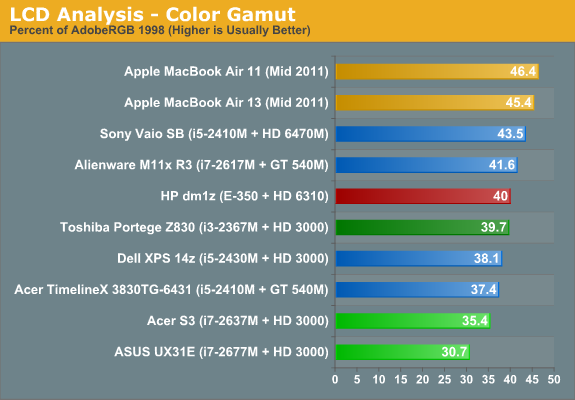
Of the laptops we’ve reviewed recently, the UX31E has the brightest LCD by far…along with the highest black level by far. The result is a contrast ratio that places near the top of our selection of eight mediocre displays. The Acer S3 on the other hand has middling white and black levels but the lowest contrast of the eight tested laptops. Continue on to color accuracy and gamut and things go from middling to lousy. The ASUS’ incredibly bright backlight results in very poor post-calibration Delta E of 3.67, with some colors in the double digits. Turn to the color gamut and we find part of the reason for that: the gamuts of both these ultrabooks are very poor, which means several of the test color patches are outside of their color range.
Viewing angles are typical of TN panels, with the vertical shots showing major color shifts. The ASUS panel does a lot better than the Acer, though neither one is great. We’ve got excellent 10.1” IPS panels now shipping in $400 tablets; why can’t we get a similar panel in 13.3” trim in a $1200 laptop? I’m probably preaching to the choir, but seriously: first IPS panel in a 13.3” laptop for under $1000 gets an Editor’s Choice award (as long as the rest of the laptop doesn’t completely suck).
In the grand scheme of things, though, how much do the LCD test results really matter? That’s a more difficult question to answer. Some users will never know what they’re missing, while others like to edit photos or watch movies and will immediately notice the poor contrast and colors. The color quality is a potential deal breaker for me, but if you’re just surfing the web and working in office applications, it really doesn’t make that much of a difference. For a go-anywhere laptop, the ASUS’ ultra bright LCD is definitely a plus—I took it outside and maxed out the backlight intensity and was still able to view the display contents without complaint, which is more than I can say for the laptops that max out at 200-250 nits.
When we look at the target the ultrabooks are trying to take down—Apple’s MacBook Air—the LCD results in particular are unacceptable. The MacBook Air displays are by no means perfect (I'd like a color gamut of at least 70% AdobeRGB for example), but notice how out of the tested laptops they place at the top in every test other than maximum brightness? That's what we'd like to see from the competition. ASUS at least made some effort to be different by going with a 1600x900 LCD with a high maximum backlight intensity, but Acer could have literally picked up any other 13.3” LCD and put in a similar showing. Take the price and OS out of the equation and the MacBook Airs are the superior “ultrabooks”, for two reasons: build quality and display quality. Acer improved their build quality over most of their budget offerings, and ASUS is right there with Apple in terms of build quality, but >500:1 contrast with >350 nits maximum brightness is the minimum I’d like to see, and really we’re talking about $1000+ laptops so it’s not too much to ask for an extra $50 to improve the displays.






















81 Comments
View All Comments
Hector2 - Wednesday, December 21, 2011 - link
I think Intel has it right with the move to Ultrabooks, but these early SandyBridge-based models without Touch aren't what I'm looking for --- though much better than the old non-Ultrabook form factor.I'll get my Win 8 Ultrabook when there's one with a nice medium size, Touch screen model with Ivy Bridge inside, that has only an external wireless keyboard (no physical keyboard buttons on the UB itself), with wireless mouse and a Thunderbolt or Lightpeak connection for an external Monitor, when desired.
This would serve as a nice, portable Touch tablet when I'm mobile but also able to use as a full blown i7 Core PC workstation for work plugged into nice keyboard, nice mouse and my 24" LCD monitor
It'll happen. Just a question now of when
Paedric - Wednesday, December 21, 2011 - link
Ivy Bridge really seems interesting, as it combines reduced power consumption with better integrated graphics.I think the CPU is already powerful enough for what it has to do, with only graphics lacking.
It will also be the second generation of ultrabooks, so a lot of "newbie" errors should be fixed.
I'm not sold on Win 8 and touch though.
I think it's the role of tablet to be able to change to notebook, not the other way around, the Asus Transformer is the perfect example of this.
Nexing - Wednesday, December 28, 2011 - link
Plenty of people wants to have a powerful, portable, battery lasting -at least for daily duties-, price competitive... sleek laptop.These ultrabooks do come close, except for the terrible omission of Intel's "Ivy bridge" 22nm CPU, which means that whatever CPU this ultrabook, (or any other released up to May 2012) comes with... will bear the almost obsolete 32nm "Sandy Bridge" CPU technology. Which means that this whole early ultrabook generation will not be battery efficient enough(4 hrs vs Ivy's 8-10 hrs of real usage, or will not run cool enough (not to be used at bed, on a coach, on your legs, etc).
Very different story to the REALLY new ultrabook laptops to be released somewhen after 2012 Q2 that will come with Ivy Bridge CPUs...
And to worse matters, those who actually buy one of these pre-Ivy Bridge Ubooks will never be able to upgrade into the coming 22nm tech, just because Intel said so (it is technically feasible and the norm for actually , confirmed to be upgradeable Sandy Bridge desktops)... So good luck with the niche & soon-to-be-obsolete 2011/Q1 2012 Ubooks,
BUYERS BEWARE!!!
seapeople - Saturday, January 14, 2012 - link
First of all, there is no Ivy Bridge, and if you want a computer within the next ~HALF YEAR then you'll have to buy one with poor old inefficient Sandy Bridge.Second of all, there's no way Ivy Bridge is going to increase battery life by 2.5x over Sandy Bridge. Just because it's a new architecture does not mean it will blow us away; Arrandale ULV laptops gave almost no benefit over Core 2 Duo ULV in terms of battery life, and actually decreased battery life in many cases (albeit with a fair performance increase, but not mind blowing).
Third, if you think current Ultrabooks with Optimus and/or integrated graphics run too hot to be used on your lap, you are insane.
Pessimism - Wednesday, December 21, 2011 - link
I'd suggest adding the MBA display data to your graphs since you heavily compare these systems to it and complain about the overall lack of display quality. Since Joe Public thinks Apple products can do no wrong and are made out of unicorn horns and fairy dust, lets see some hard data.JarredWalton - Wednesday, December 21, 2011 - link
Added. Obviously we don't have the performance results for the MBA on most tests, but the LCD results are at least something we can easily compare.Pessimism - Thursday, December 22, 2011 - link
Thanks! Hopefully with enough direct numeric comparisons in reviews we can convince PC makers to stop using horrible, horrible panels.Deelron - Wednesday, December 21, 2011 - link
Occasionally Joe Public isn't wrong.UrQuan3 - Wednesday, December 21, 2011 - link
"but seriously: first IPS panel in a 13.3” laptop for under $1000 gets an Editor’s Choice award (as long as the rest of the laptop doesn’t completely suck)."That might be my favorite quote from this site. I hope some vendors are reading. I've been wanting and sRGB under 14" laptop for a decade. Settled for a Samsung 9 for now. Far from perfect, but it'll do for now.
jasondunn - Wednesday, December 21, 2011 - link
I purchased a UX31 in October. I wanted it so badly I paid $68 to get next-day shipping because I was traveling and wanted it before I left. There are many things that are excellent about the UX31: I was impressed with the screen, the performance, the speed of sleep resume and boot, etc. But there's a *giant* problem with this laptop: the keyboard requires a heavy-handed style of typing. I type quite quickly, and apparently I type too "light" for the UX31.I've owned and used well over a dozen different laptops over the past decade, and the UX31 is the first where I found typing to be a disaster. I don't use that word lightly: I'd venture that 25% of all keystrokes were dropped. That means every single word I typed longer than a few characters would have errors it it. I contacted Asus support, they had me install a software update, and nothing changed. I went to a local Microsoft store and used the UX31 display model...it had exactly the same problem. If I slowed down and typed with more force, I got 100% accuracy. I don't believe I had a defective UX31 - I think this is simply the awful keyboard that Asus put in it.
I should add that I found Asus' tech support to be quite lacking and would be very wary of dealing with them again.
So my advice is this: make sure you're able to test the keyboard in person before putting down $1000+ to buy it. I regret my purchase and had to settle for a $1349 in-store credit rather than getting my money back.